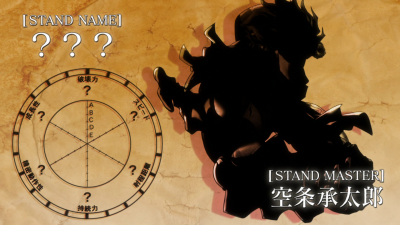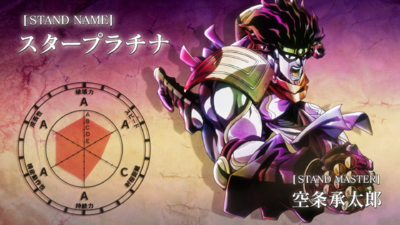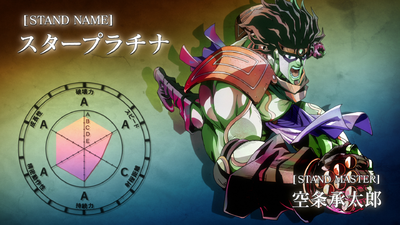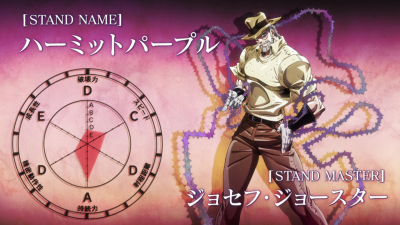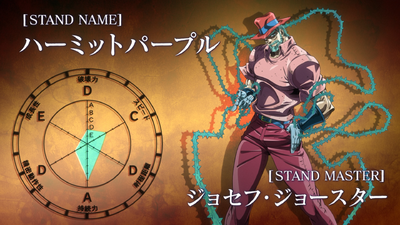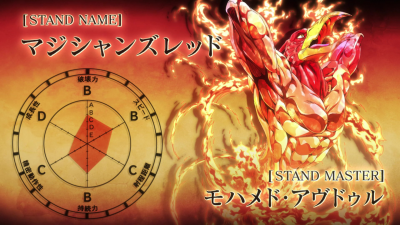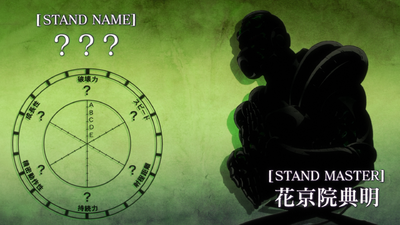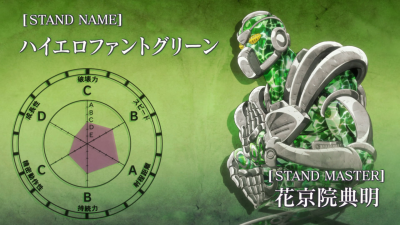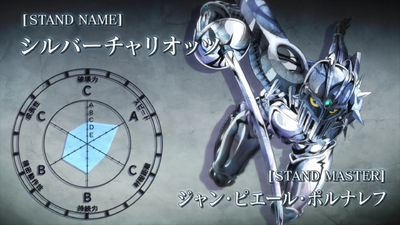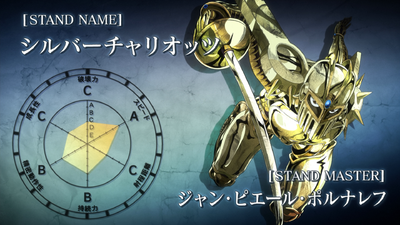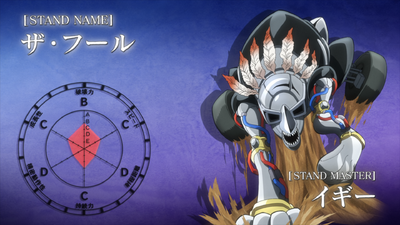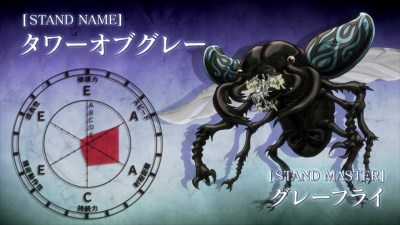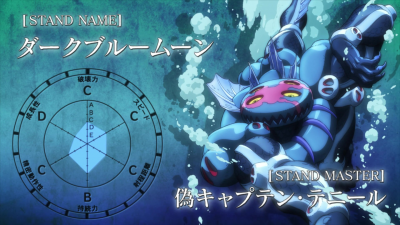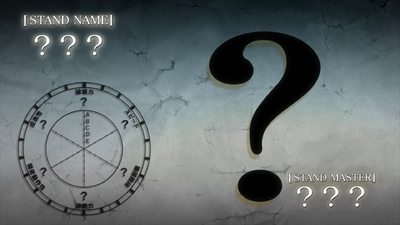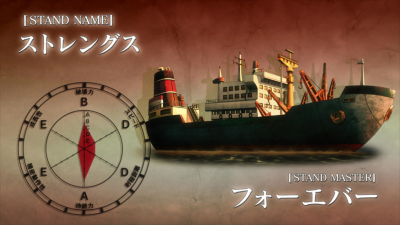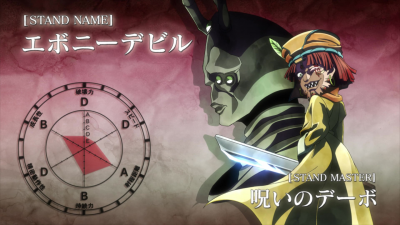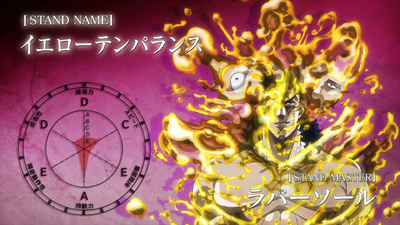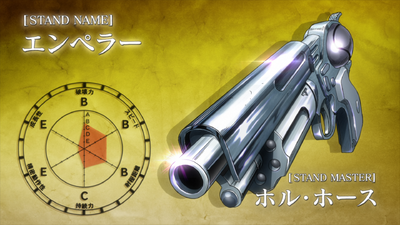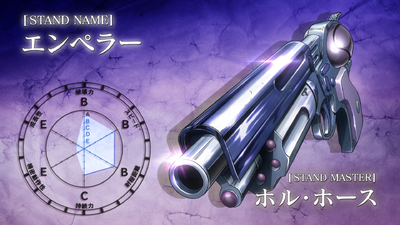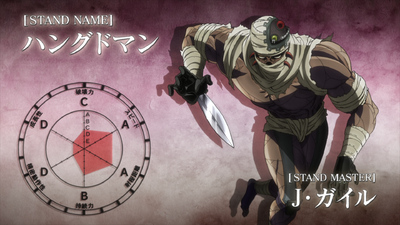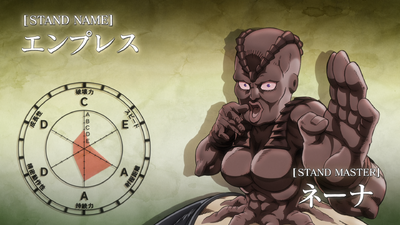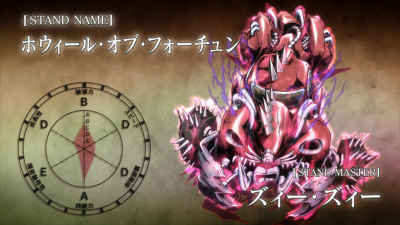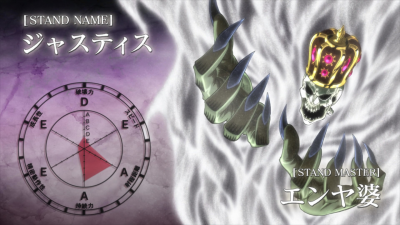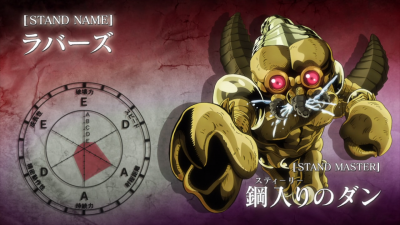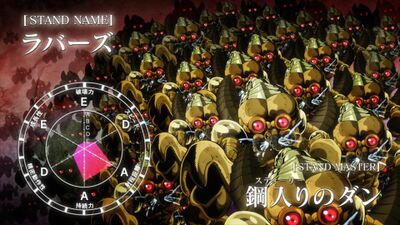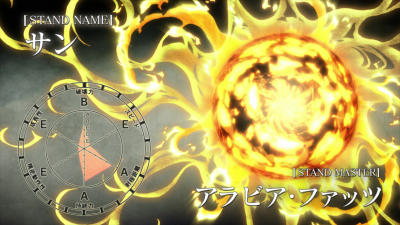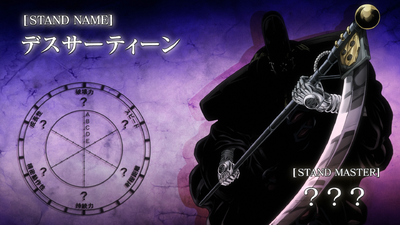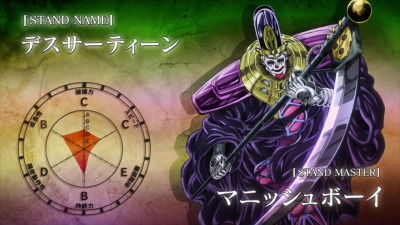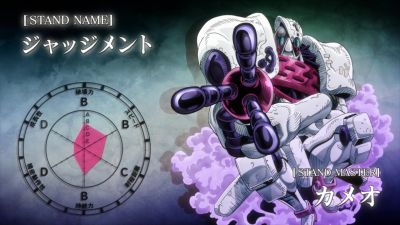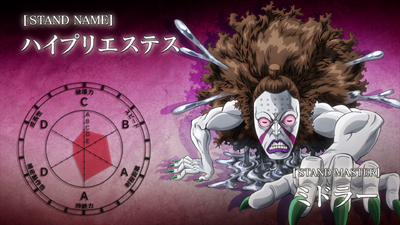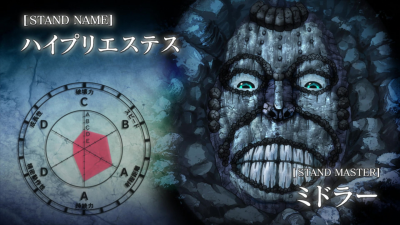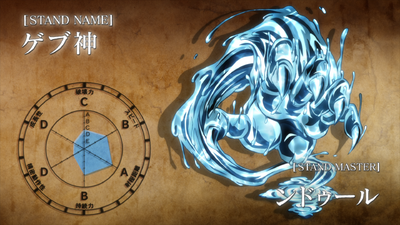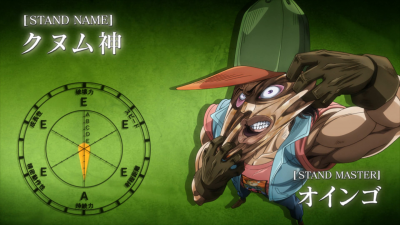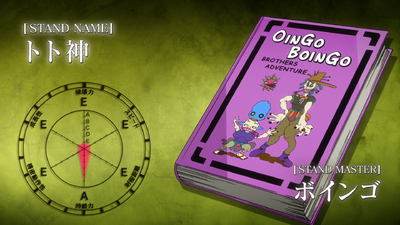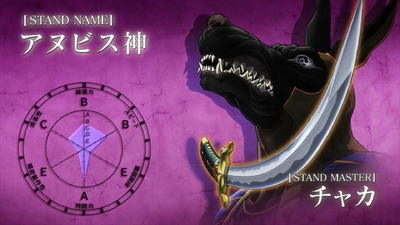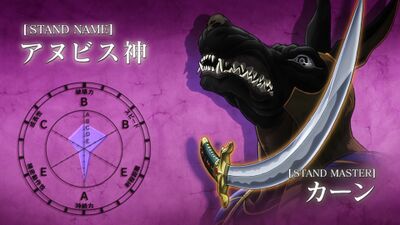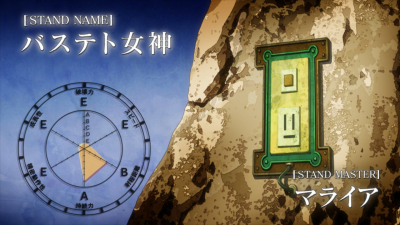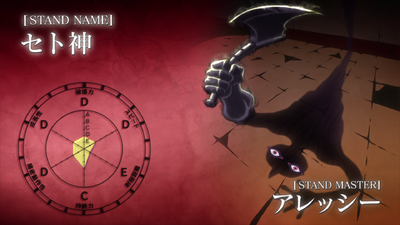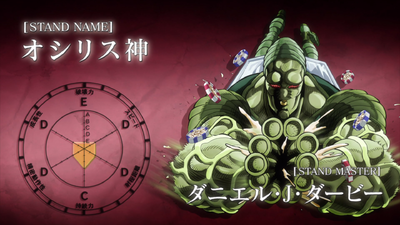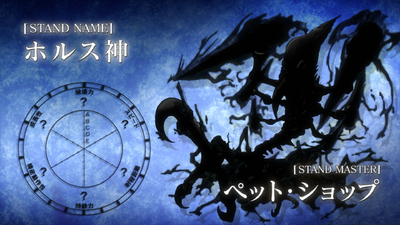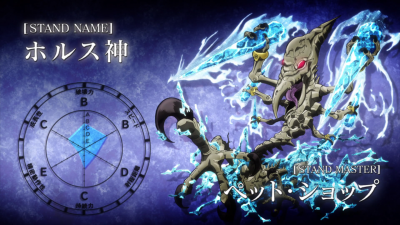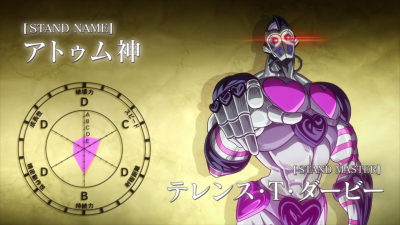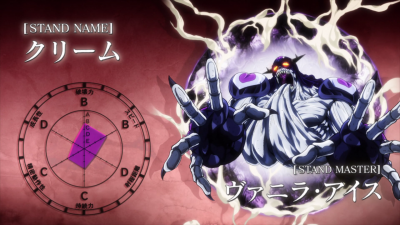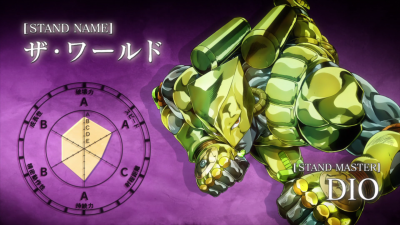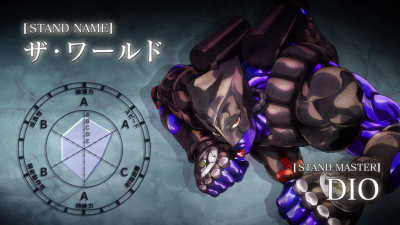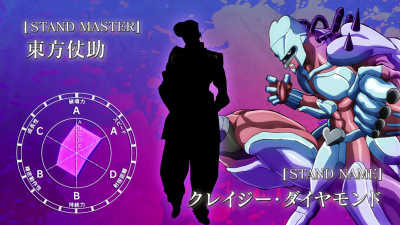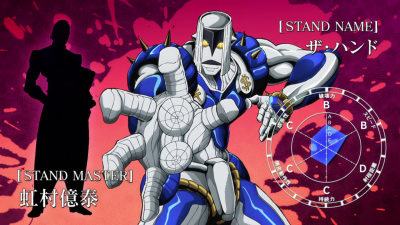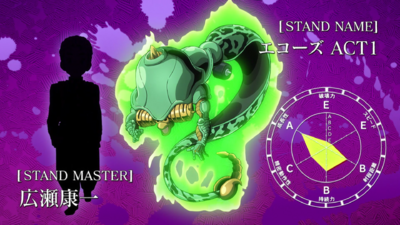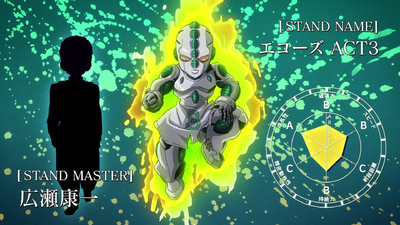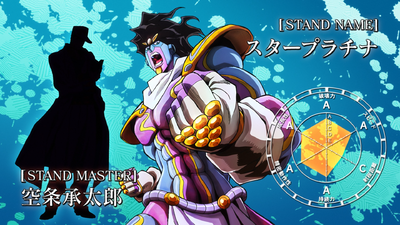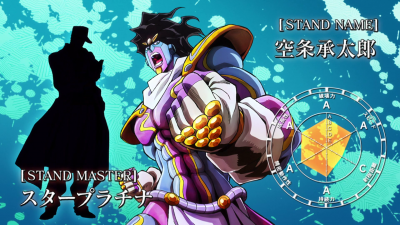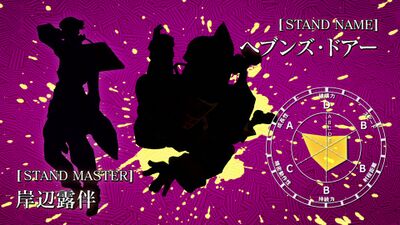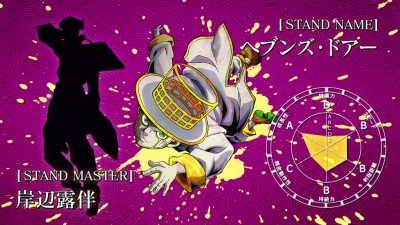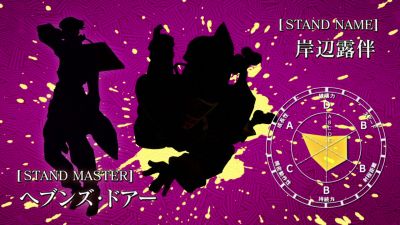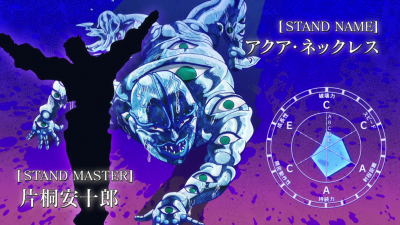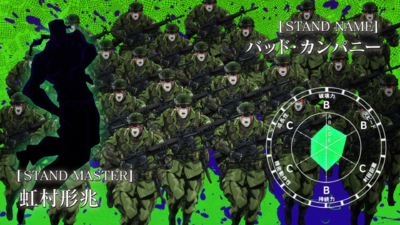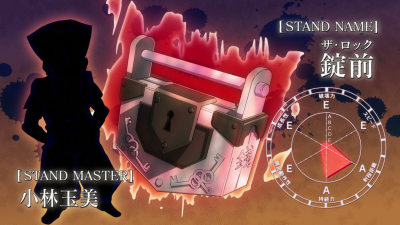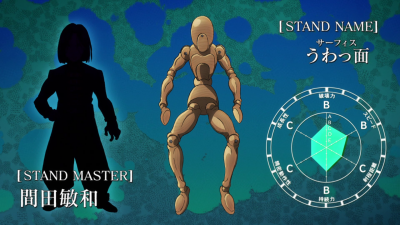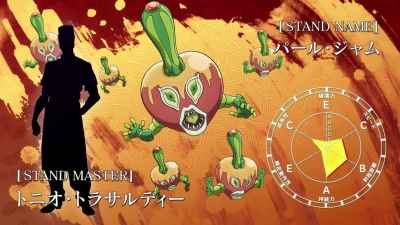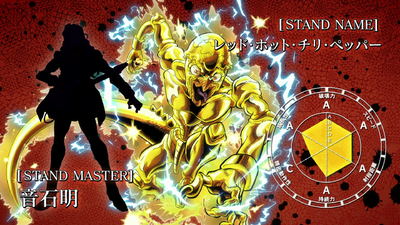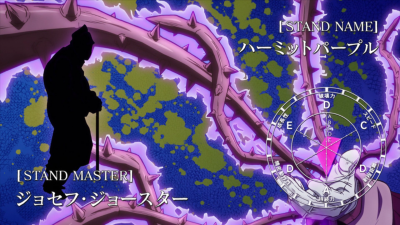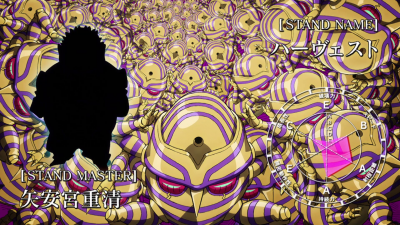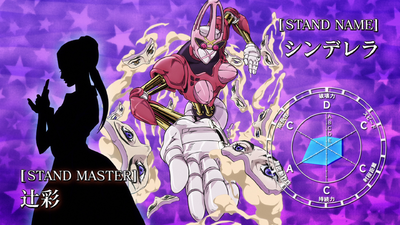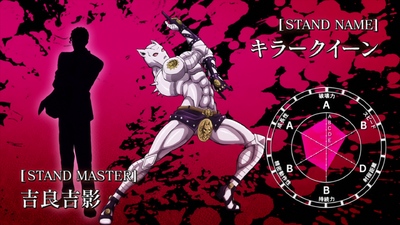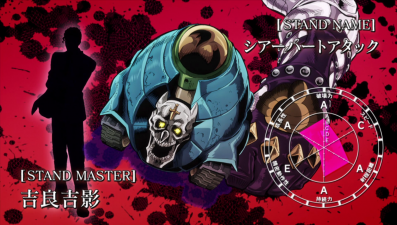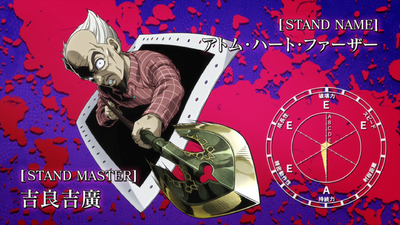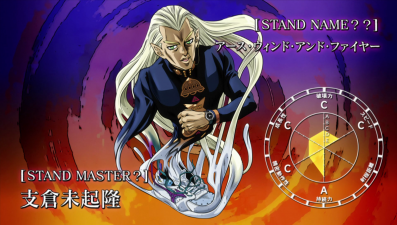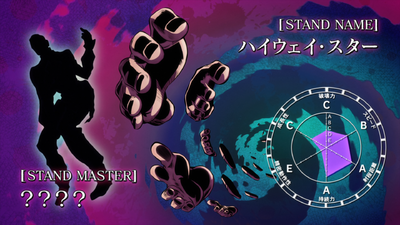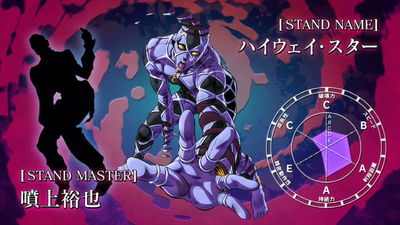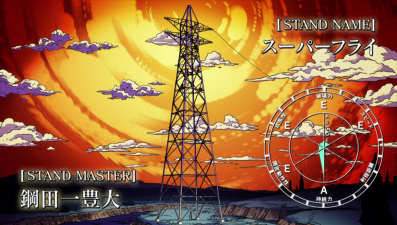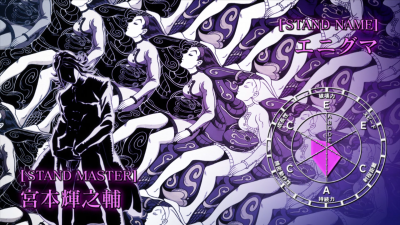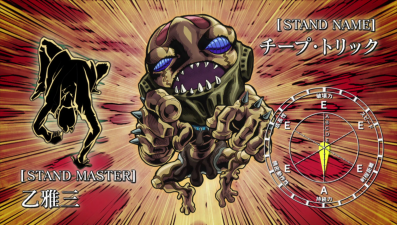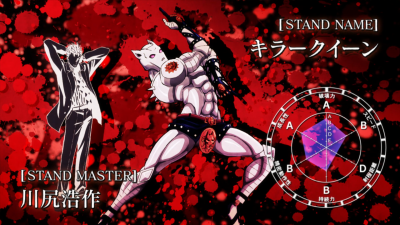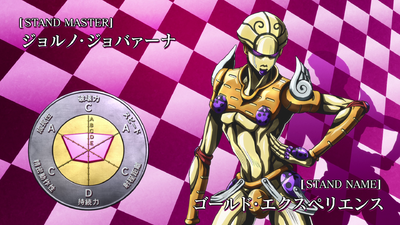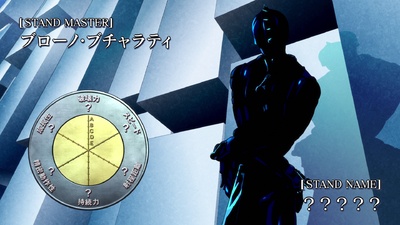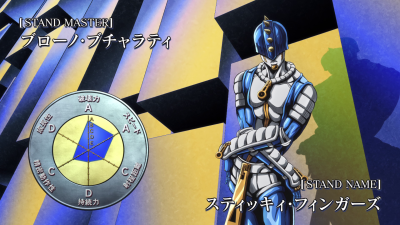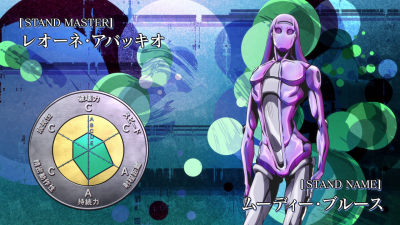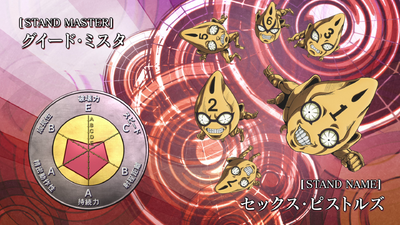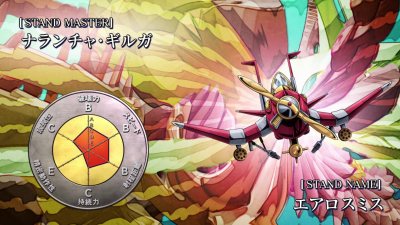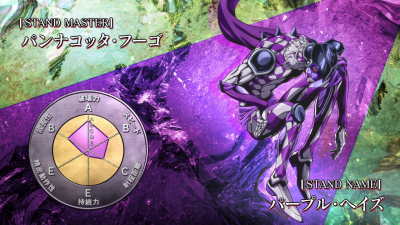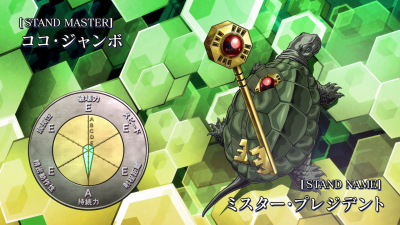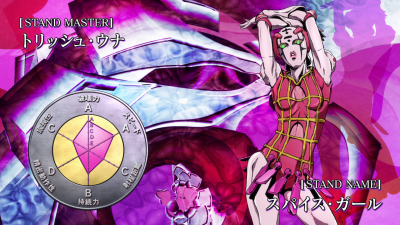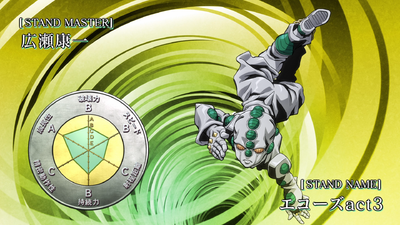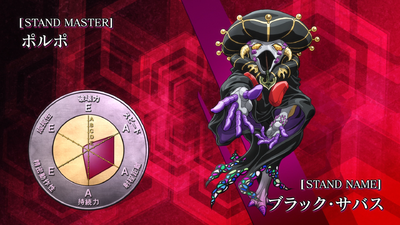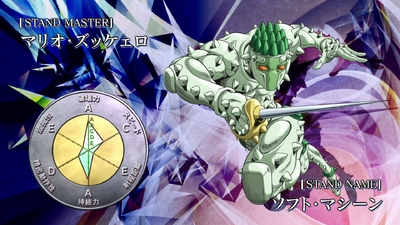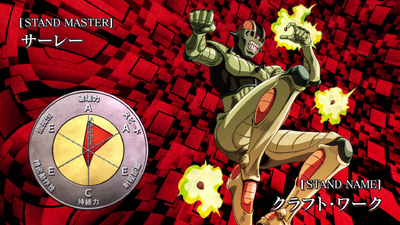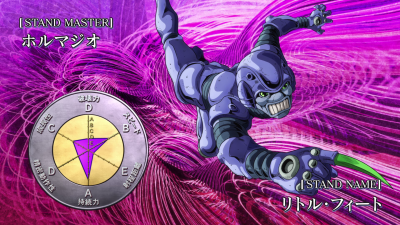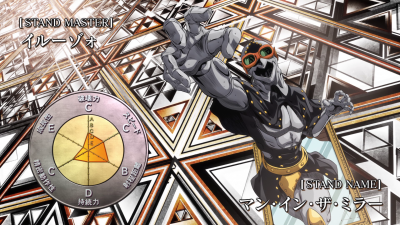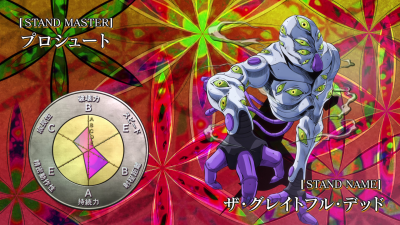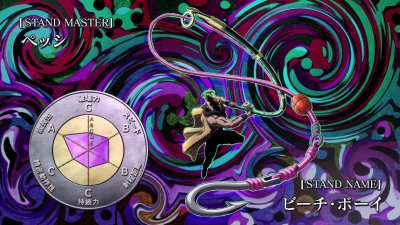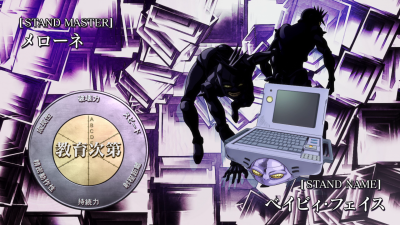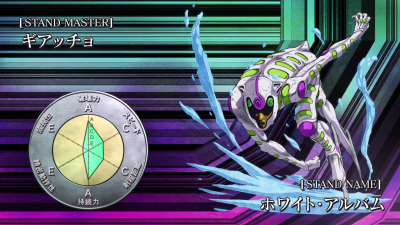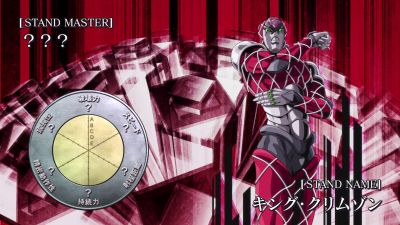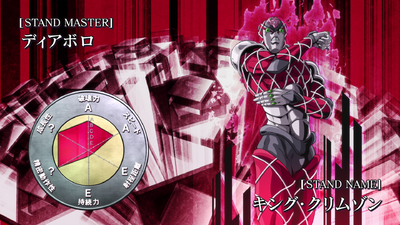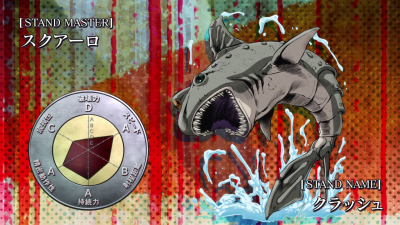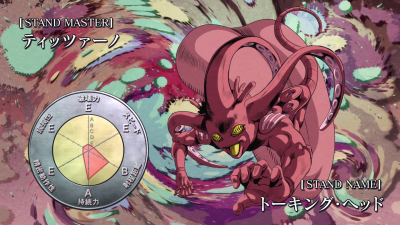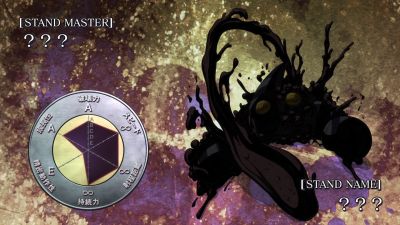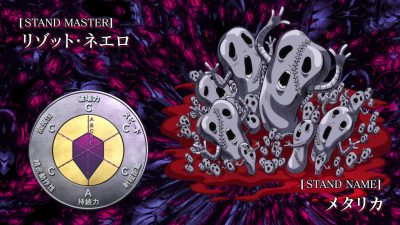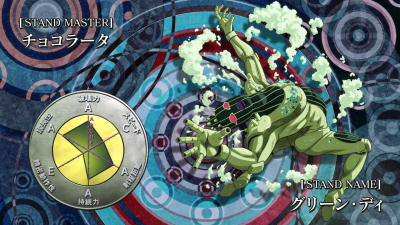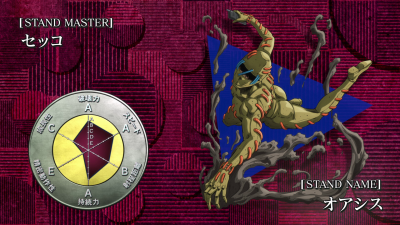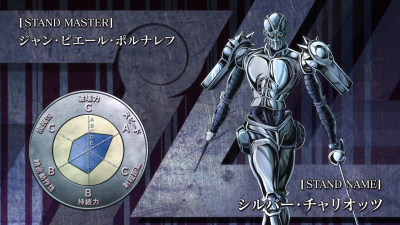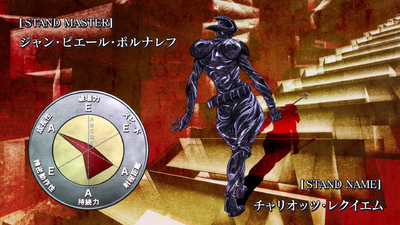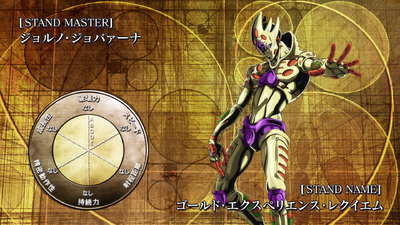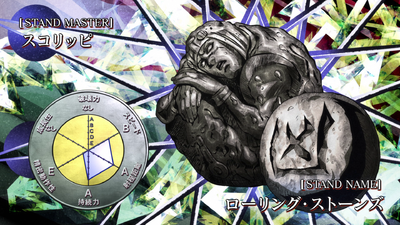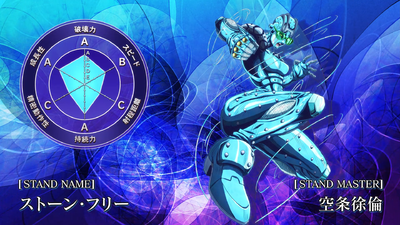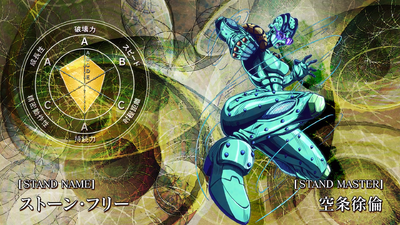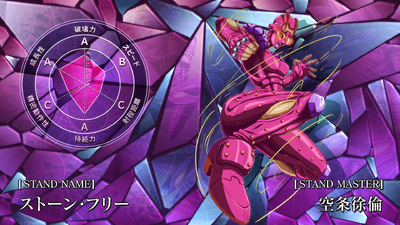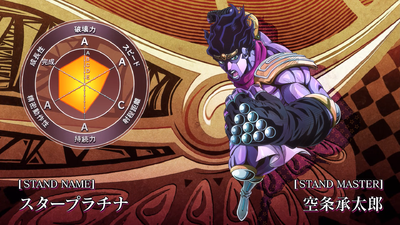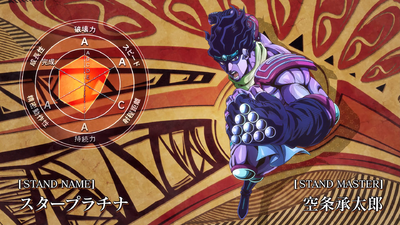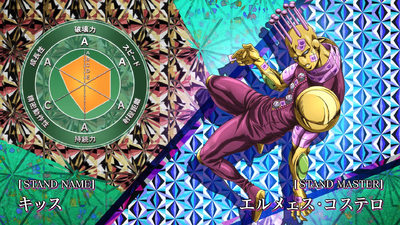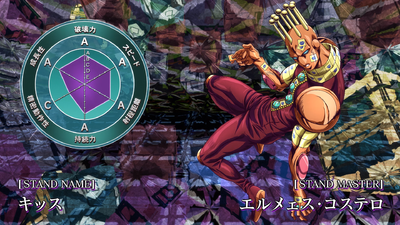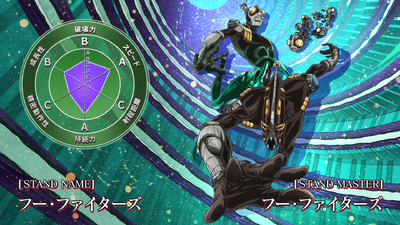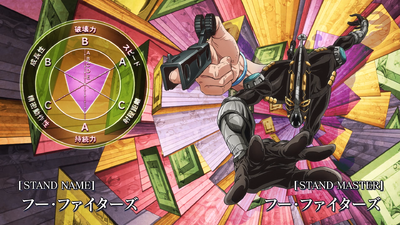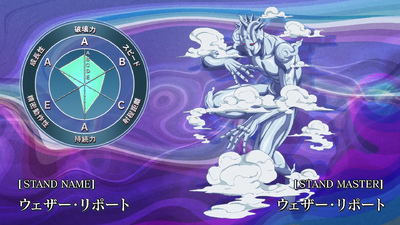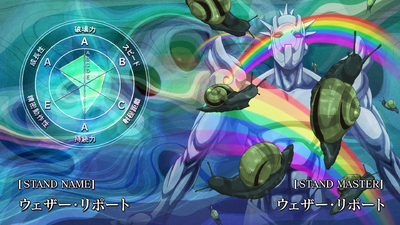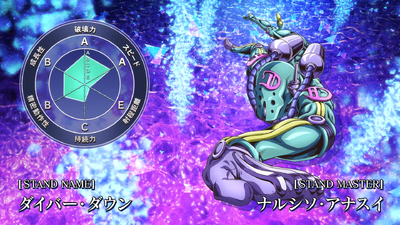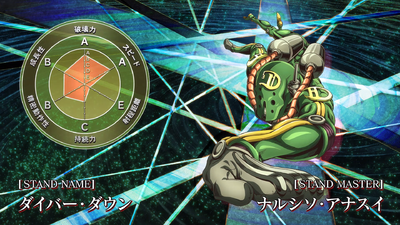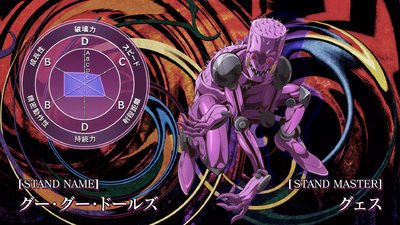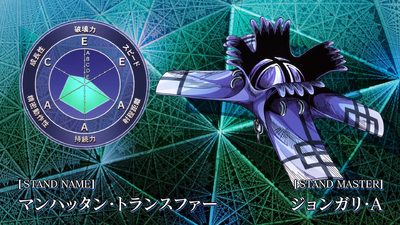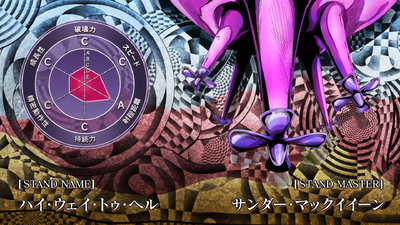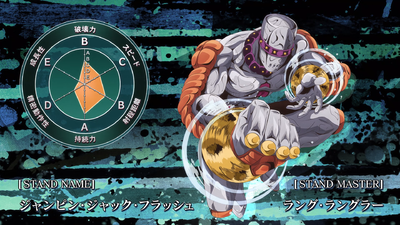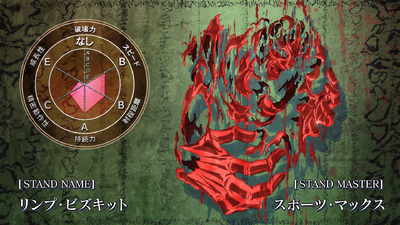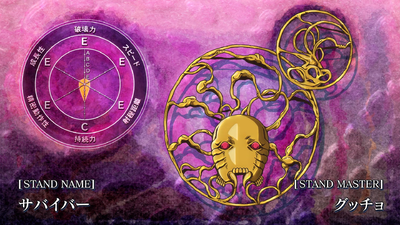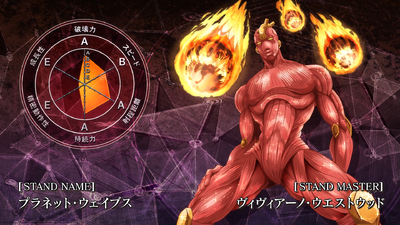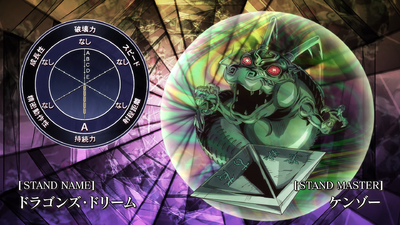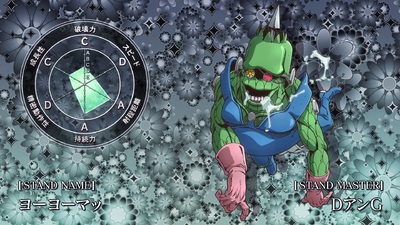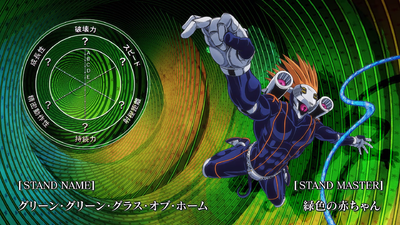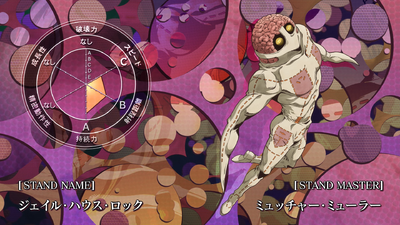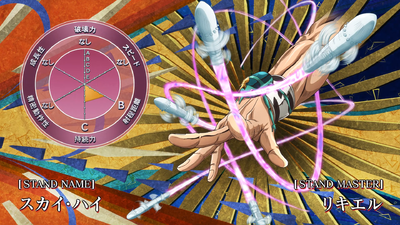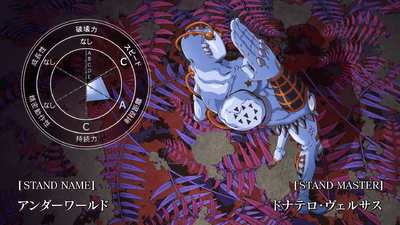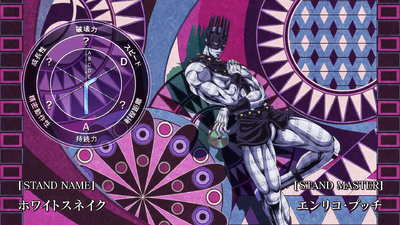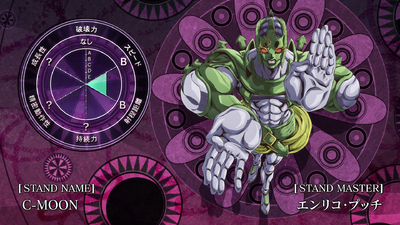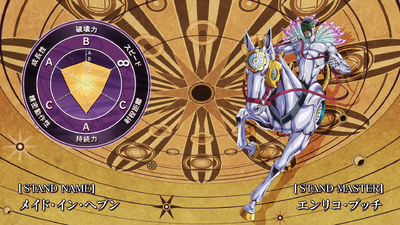Stand
A Stand (スタンド, Sutando) is a physical manifestation of a person's "life energy".[4] It is a power unique to the JoJo's Bizarre Adventure series.
A Stand is an entity psychically generated by its owner, referred to as a Stand user (スタンド使い, Sutando tsukai).[5] It generally presents itself as an ethereal figure hovering over or near the user and possesses abilities beyond that of an ordinary human, which, depending on the Stand user, can be wielded for good or evil.
Summary
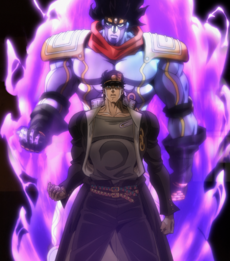
Stands are defined as personifications of "life energy" (生命エネルギー, Seimei enerugī) whose abilities are given visual form. When first presented, the term is written as
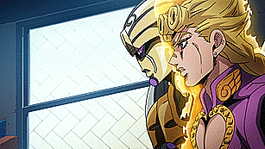
To an extent, a Stand embodies the individual's psyche, usually as the representation of their user's "fighting spirit". However, the will required to manifest a Stand doesn't need to be confrontational, deriving from any exploration of the mind's possibilities, be it mastery of a craft, strong desire or even personal crises. Beyond that definition, Stands present themselves in a large variety of forms and with different behaviors, if they are sentient at all. They follow a loose set of rules, with no definite standard by which one can fully classify them. As an embodiment of someone's psyche, Stands are therefore as varied as human minds can be.
Due to their diversity, Stands are not made equal. Some can be incredibly powerful due to their user's outstanding grit, others can be highly situational because of a defining quirk of character, or even detrimental to their user if they do not have the necessary fighting spirit.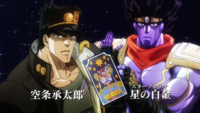
When Stands were first introduced in Stardust Crusaders, they were named after Major Arcana of the Tarot and then Ancient Egyptian deities, with their designs often featuring motifs of those cards or mythological figures. Towards the end of Stardust Crusaders and in all subsequent story arcs, the vast majority of Stand names are references to musicians, bands, albums, and songs from American, Australian, British, and European music scenes; only one Stand's name has ever referenced Japanese language music.[7]
Stands and other supernatural abilities, like the Ripple, the Spin and the powers given by the Stone Mask, are all somehow linked in nature.[8] These abilities are said to be one of the potential stepping stones towards developing a Stand, which some Stands are an example of.
Stands are also connected to an alien virus contained in the rock of a meteorite that fell in Cape York, Greenland. It is explained that the virus can infect people and for the most part kills them, but the few who survive are granted a Stand ability.[9]
Rules
The Stand is created from someone's psyche, which includes not only humans but also other living creatures. That individual is referred to as the Stand user. The user then gives their Stand a name and uses it for various purposes.
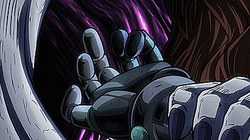
Unless bound to a specific object or automatic, Stands are attached to their user's body. In that case, any damage the Stand sustains results in an equivalent injury on the user's body and vice-versa. Exceptions to this rule include automatic Stands and bound Stands, which usually do not reflect the damage into the user, or special abilities like Silver Chariot's armor.
Except for rare occasions, when a Stand user dies, their Stand and ability disappears with them. If a Stand suffers so much damage they are destroyed, the user dies as well. However, a user can survive with their Stand destroyed[10] if the Stand is automatic or depending on the level of the user's injury. Inversely, some Stands can survive beyond their users through exceptional abilities like Notorious B.I.G.
Since a Stand is the form of its user's psyche, they share an intimate psychic bond. First and foremost, Stands usually obey their users' command without question. If a user demands it, the Stand will perform any task within its capacities, which includes attacking someone, defending the user, or any miscellaneous order. In the case a Stand is sentient, they can occasionally advise their user that an order is unwise but will carry it on all the same. Stands are also shown to protect their users in certain instances, such as when Jotaro tries to shoot himself,[11] or Weather Report tries to commit suicide.[12]
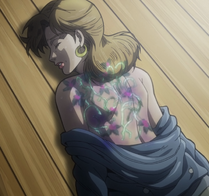
However, there are instances when a Stand cannot be controlled by the user. It can be either automatic like Super Fly or the user can acquire a Stand but not have the fighting spirit to control it like Holy Kujo.[13] In both cases, a Stand can accidentally work against its user's interests through their unsupervised power. However, specifically in the second case, a Stand can go out of control and slowly kill its user like a disease. According to Muhammad Avdol, the user becomes ill, then falls into a coma only to never wake up again; moreover, such occurrences are common enough for him to claim having witnessed many people succumbing to this.[13]
One of the defining rules about Stands is that someone may only have one Stand (at a time). Although Stands may take different forms, or be split into several entities, no one is able to summon several Stands at once. Although exceptional circumstances may lead to someone wielding several Stands, only one will be the user's bona fide Stand. A Stand generally remains attached to its user, but it can sometimes change users. For instance, it can be stolen from its original user, or if the Stand's ability involves changing users. Thanks to Whitesnake's DISCs, a Stand can change users but will act to protect its new user instead. Others Stands, like Anubis or Cheap Trick, will actively try to change users, and their malevolent nature makes them harm their users instead of protecting them.
Occasionally, a Stand can emit a Stand Cry, shouting repeatedly while delivering a beatdown.
Manipulating a Stand
When a user acquires their Stand, their control over it is partly instinctual but needs practice.
When a user discovers their Stand, they usually do not know anything about it and thus has to figure out what their power is. Sometimes the ability is straightforward and easy to understand like Koichi Hirose's Echoes, at other times a sentient Stand may explain the power directly to its user as Spice Girl did for Trish Una,[14] but sometimes the user will need time to know their Stand's power. For instance, both DIO and Jotaro possessed their Stands for some time until they discovered that they could stop time.[15]
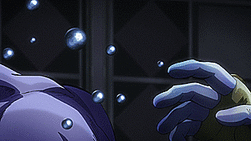
Afterward, it is up to the user to discover what their Stand can really do with its ability. A Stand user will need practice to develop their Stand's potential and manipulate it in a more precise manner. Hidden subtleties and applications of the Stand's power may require time for the user to notice. Giorno Giovanna, for example, had to use Gold Experience on Bruno Bucciarati to discover what its Life-Giving ability did to humans,[16] and similarly had to figure out that its abilities could mend wounds.[17]
To use a Stand, the user has to consciously summon it. Likewise, to use its power, the user has to command their Stand. Thus, Stand users are still vulnerable to sneak attacks. This does not apply to automatic Stands which act by themselves.
In the Crazy Diamond's Demonic Heartbreak spin-off, the character Karaiya claims that animals with Stands have less willpower than their human counterparts and thus their powers are held back by their natural instincts and that another brain is needed as a controller to bring out the full potential of the Stand power. He himself has somehow managed to link his soul to a parrot by giving it a piece of his ear, and is thus able to control the power of the parrot (Karaiya says that they "share the same Stand") as well as enhancing it so that it can now also project the memories recorded by the parrot onto others.[18]
Acquiring a Stand
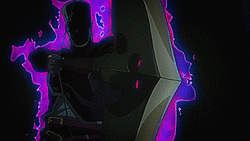
In most cases, Stand users are either born with the ability to use their Stands at an early age or have the potential to unlock one later in life. This Stand potential can notably be inherited.[19] For those who have the potential, the trigger for unlocking one's Stand varies with the user, but is often related to the refinement of their talents or skills throughout their life. As such, a Stand's awakening and abilities are often tied to the user's occupation.[20] Stands are also noted to awaken through the mere presence of powerful Stand users in the general area.[21] Notable users who acquired a Stand through natural means include Noriaki Kakyoin, Muhammad Avdol, Tonio Trussardi, Scolippi, and Kenzou.
The most widespread way to trigger a Stand's awakening immediately is to be pierced by a special Arrow made from a meteorite in Greenland. If a person has Stand potential, they will survive being stabbed and acquire a Stand; otherwise, they will die. Notable users who unlock their Stand this way include DIO, Koichi Hirose, Diavolo, Enrico Pucci, and Jolyne Cujoh.
Moreover, if someone acquires a Stand this way, their existing descendants will also gain a Stand, although it may not manifest itself at first or be uncontrollable. In one such case, Jonathan Joestar's body was pierced by the Arrow, causing every living member of the Joestar Family to awaken their own Stands. The way siblings acquire Stands is portrayed inconsistently: although Koichi Hirose's sister Ayana Hirose did not awaken a Stand, twins Enrico Pucci and Wes Bluemarine both awakened a Stand when Enrico was pierced.
In the new continuity first seen in Steel Ball Run, the Arrows are not present. Stands can still be developed naturally, like Pocoloco's, and their potential can still be inherited, as shown with the Joestar and Higashikata families. Outside of these means, Stands are usually brought out by certain supernatural landmarks. Enduring the harsh conditions of the Devil's Palm, a shifting landmass in North America, or living long enough near the Wall Eyes of Morioh can draw out one's Stand. Notable Devil's Palm survivors include Mountain Tim, Oyecomova, and Ringo Roadagain, while many Morioh residents such as Ojiro Sasame, Daiya Higashikata, and most Rock Humans unlock their Stands through mere exposure to Wall Eyes emergence sites.
The power behind both the Devil's Palm and the Wall Eyes stems from the Saint's Corpse, a set of mummified relics with miraculous properties. Among them is the ability of individual Corpse Parts, usually buried at the eye of a Devil's Palm, to grant Stands to worthy bearers along with ownership of the Corpse Part. Because the user's capacity to wield these Stands is initially tied to the Corpse's own holy power, they can be lost if the Corpse Part is extracted. However, as the user acclimates and develops their technique, the Stand can eventually become fully theirs to keep, like in the case of Johnny Joestar's evolving Stand, Tusk.
Uniquely, the Saint's Corpse can also grant Stands to the surrounding flora, creating cursed locales like Sugar Mountain Spring or Shakedown Road, and also manifest entirely separate Stand-like entities dubbed "guardians" to aid in bestowing Corpse Parts. A Stand of a Corpse Part bearer might initially be one of these guardians, as was the case with Tusk.
Spiritual Connections
Stand users share a number of spiritual connections with each other, which manifest in several supernatural phenomena.
Firstly, Stand users attract other Stand users. Likened by different characters to either a "red string of fate" or "gravity", this link ensures that Stand users will eventually meet one another, especially if they live in the same general area. This rule was most prevalent in Diamond is Unbreakable and Vento Aureo, where many fateful meetings, such as Koichi Hirose immediately bumping into Giorno Giovanna when tasked to find him,[22] had this phenomenon as their undercurrent explanation.
Secondly, if Stand users happen to be related to each other, they will share a strong psychic bond. It's most prominently exhibited as an ability to sense the presence of Stand using relatives. Even without having met each other in person, people sharing this link will be able to roughly tell how far away they are from each other, although they usually can't discern the exact direction the sensation is coming from. They can also tell if their family members are alive regardless of distance.[23][24] These nuances were, for example, used in the battle with DIO, when the retreating Joseph Joestar "masked" the presence of Jotaro Kujo closing in on DIO from the back,[25] and were also the main reason for why the Boss of Passione considered killing his estranged daughter Trish Una essential to maintaining complete anonymity.[26]
If the familial ties between Stand users are especially strong, such as the bond between twins or loving parents and children, the people in question will sometimes share injuries or even supernatural changes to their body.[27] This was showcased with Enya Geil manifesting her son's stab wounds after his death,[28] and Jotaro subconsciously sending a message to Jolyne Cujoh via Star Platinum carving her name in his skin.[29]
In the second continuity, only the rule of Stand user attraction is shown to be in effect.[30]
History
- See also: Bow and Arrow and Saint's Corpse
The "Stands" in JoJo can be conceptualized as a reification of hidden talent, with their source being a sort of energy that's been in the Earth since ancient times.[31] The oldest known instance of a Stand user dates back to the 16th century with the death of Caravan Serai and the emancipation of his Stand, Anubis.
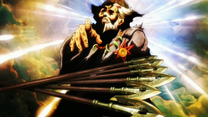
Approximately 50,000 years ago, a meteorite crash landed on Earth around an underpopulated region of Cape York, Greenland. Several hundred years before the discovery of the virus, a man who wished to acquire the power of gods took the rocks and fashioned them into a set of Arrows. What happens to them through the centuries remains unknown.
In 1978, a mineral excavation team discovered the meteorite and uncovered an unknown virus within the rocks of the surrounding area and determined that it has been laying dormant inside the meteorite that hit Earth long ago. Despite extensive research, government doctors were unable to determine the alien virus' purpose outside the culling of life. Akin to the theory of evolution, it was discovered that certain people possessed the quality that would allow them to survive when exposed to the virus, rewarding them new abilities as they surpassed the trial.[32]
The Arrows resurface in 1986 when an Egyptian ruins investigation team uncovered six of them from underneath the Egypt desert. The Arrows were eventually stolen by Diavolo, who sold five of them to Enya the Hag. The Arrows allowed the wielder to unlock Stand abilities in those who had the potential to awaken one, essentially acting as the aforementioned trigger. Thus since the '80s, there has a been a sharp rise in the population of Stand users. The five Arrows sold to Enya were eventually distributed between various people across the world, among them were Keicho Nijimura, Yoshihiro Kira, Jean Pierre Polnareff, and the Speedwagon Foundation.[33]
El Aleph
In the light novel El Aleph, a magnitude 8.1 earthquake struck Peru in 1966. It caused large deformations in the earth's crust below the mountain range. Speedwagon Foundation investigators carried out a geographical investigation in Pucallpa, and found an area with a new, large-scale depression. However, researchers that entered that area suddenly suffered from unexplained illnesses resulting in unnatural deaths. Some of the researchers that survived exhibited strange changes in their bodies, such as spontaneous combustion or electrical discharge. The cause was a strange mineral that had been exposed by the earthquake, causing them to be infected with an unknown virus.
Lisa Lisa learned that in the distant past, there were cases of people finding and harvesting the same mineral in regions other than Peru for their own purposes. The ore was carved to make Arrows, eventually leading to several of the Arrows being spread throughout South America and other regions.[34]
The Speedwagon Foundation investigators in South America call the power awakened by the Arrows "la Maravilla"
Not satisfied with the existing names for the ability, Joseph Joestar asks Lisa Lisa what she thinks it should be named. She suggests "Friend" but Joseph believes that to be too mellow. Instead, while listening to the song Stand by Me by Ben E. King on his Walkman, he decides on naming the term "Stand" after hearing from Lisa Lisa that Joaquín was a friend standing by Octavio's side.[3]
Second Continuity
Stands are reintroduced in later parts with much vaguer origins. In Steel Ball Run, Stands were described as being granted by the Devil's Palm and the Corpse Parts it housed, which both bestowed power to those that could seek them out and survive their presence. In 1890-1891, to reassemble the Saint's Corpse and gain control of its miraculous power, the United States government staged the eponymous Steel Ball Run race as a way to scour the territory for individual Corpse Parts under the guise of a public event. The full Saint's Corpse was then sealed under Trinity Church, Manhattan, after which the Devil's Palm seemingly ceased to be.
The Saint's Corpse was then briefly smuggled into Morioh, Japan in 1901 by former Steel Ball Run contestant Johnny Joestar to cure his wife's terminal illness through the Corpse's power of Equivalent Exchange. As Johnny died in the process, the Corpse was retrieved by US government agents and returned to America.[37] Consequently to these events the grounds of Morioh started exhibiting strange properties, one of which was the ability to draw out Stands. Despite the Wall Eyes, a geological formation similar to the Devil's Palm, emerging in Morioh only during the 2011 Tōhoku earthquake, a lot of the town's Stand users have awakened their Stands long before that, many having lived next to or on top of future Wall Eyes emergence sites.[38][39]
Despite an established connection between the Saint's Corpse and Stands, much of the specifics are shrouded in mystery. People who live near Stand-granting landmarks sometimes offer alternative explanations of their origin. For example, according to a Native American legend, the Devil's Palm was a crater left by an ancient meteorite, similar to the one used to create the Arrows in the original continuity.[40] A significant number of Stand users also never came in contact with either the Saint's Corpse or the formations it left behind. Finally, it's up to interpretation whether the Corpse's power is something shared among other similar relics, as some characters have implied,[41] or is simply an extension of an ability the Saint had in life.
Stand-endowing grounds have also historically been connected to the cryptid species of Rock Humans, the vast majority of whom are Stand users. Rock Humans hold a great reverence for the powers found within the Earth, and as such they're drawn to places like the Devil's Palm and the Wall Eyes, considering them their "true home".[42]
Appearance
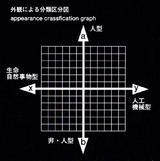
Stands present themselves in a wide variety of forms. Some adopt a humanoid form, others, the appearance of an object or a tool. These Stands all share an inability to be viewed by ordinary humans, unless bound to physical objects. In addition, some Stands can simply be devoid of appearance, simply manifesting themselves as a special power.
Stands can be divided into 5 trends based on their physical appearance. The first four are categorized using the following descriptors: Natural (生命・自然事物型 Seimei Shizenji Butsu-gata, lit. Living/Natural Things), Artificial (人工・機械型 Jinkō Kikai-gata, lit. Artificial/Mechanism), Humanoid (人型 Hito-gata) and Non-Humanoid (非・人型 Hihito-gata). A fifth category, referred to as Phenomenon (現象型 Genshō-gata) or Other (その他 Sonohoka), exists to encompass all Stands that do not fit into any of the previous trends.[43]
| Classification | Summary |
| Natural Humanoid | Stands in this category have physical characteristics similar to human beings, most often their users. Obvious identifiable features include arms and legs, but the category distinctly specifies appendages that are reminiscent of the human muscular system as well as having working eyes and mouth. Stands that apply to this category include Star Platinum, Magician's Red, Hanged Man, The World, Crazy Diamond, Heaven's Door, Killer Queen, Gold Experience, Sticky Fingers, Purple Haze, Baby Face, Spice Girl, and Chariot Requiem. |
| Artificial Humanoid | While also having humanoid-like bodies, Stands in this category feature artificial or mechanical nuances that separate them from natural humanoids. This includes having completely non-humanoid facial features, tubing or mechanical joints. Appearances that resemble robots, cyborgs or androids are applicable here. Examples of Artificial Humanoids include Hierophant Green, Silver Chariot, Ebony Devil, Death Thirteen, Osiris, Cream, The Hand, Bad Company, Cinderella, Echoes, Black Sabbath, Moody Blues, White Album, and Green Day. |
| Natural Non-Humanoid | This category features Stands that, while not human-like, are reminiscent of other life forms or objects in nature. This includes basic organisms such as animals and plants, but also more unorthodox concepts such as fog. Stands that may be described as "monster-like" are often applicable here. Stands in this category include Hermit Purple, Tower of Gray, Yellow Temperance, Lovers, Justice, Sun, Horus, Stray Cat, Sex Pistols, The Grateful Dead, Notorious B.I.G, Metallica, and Rolling Stones. |
| Artificial Non-Humanoid | Stands comparable to instruments or mechanical objects are placed in this category. This includes vehicles, weapons, and machines. Stands in this category include Strength, Emperor, Wheel of Fortune, The Fool, Ratt, Aerosmith, and Beach Boy. |
| Phenomenon | Stands in this category typically either don't have clear appearances or are integrated into their user's appearance. This includes Stands such as Tohth, Khnum, Tenore Sax, Love Deluxe, Achtung Baby, and Atom Heart Father. |
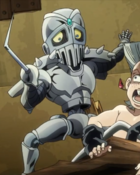
A Stand's appearance is not set in stone. Stands change appearance as their users age. As seen with Jean Pierre Polnareff's Silver Chariot[44] or Jobin Higashikata's Speed King,[45] young Stand users have typically childlike Stands and when they become adults, the Stands' features also become adult-like. A special category of Stands that can evolve into different forms or Acts, is also able to change form and therefore appearance. Finally, a Stand pierced by the Bow and Arrow can evolve into a brand new form called a Requiem Stand.
When a Stand is injured, they may either bleed like an organic being, crumble into ashes, fizzle out in flashes of light, or break into small pieces like a statue.
Personality
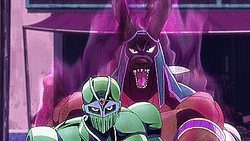
Most Stands display no personality, sometimes because they do not have a form with which to emote, but the majority of humanoid Stands simply hover behind and above the user awaiting a command. Some Stands display bits of personalities through facial expressions, but it is ambiguous whether the emotions come from the Stand or simply reflect the user's state of mind. Stand users can talk through their Stands as a way of communicating with their friend or foe.
For unknown reasons, a handful of Stands do have a separate consciousness from their users. They are sentient and can converse with their users whenever they are summoned. Although they display a variety of personalities, most still obey their users to the letter. Examples of such Stands include Echoes ACT3, Sex Pistols, and Dragon's Dream. Rarely, these Stands are uncontrollable and have no true master, and instead, move from host to host and actively seek to harm their "user" with their powers. Anubis and Cheap Trick are examples of such Stands.
Whenever a Stand talks, their otherworldly nature is indicated in the original manga material as a text written with Katakana. In the case of audiovisual media such as the anime or a video game, a Stand's voice will possess a ghostly echo or mechanical tone.
Abilities
Each Stand possesses supernatural properties as well as a special, unique power, indirectly granting its user superhuman abilities:
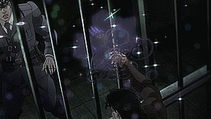
- In general, a Stand is invisible to normal humans, yet can interact with normal objects. It allows the user to use their Stand unnoticed by a large majority of the population. The mundane use of a Stand has been likened to a poltergeist phenomenon by normal people. Even a Stand's power is invisible for ordinary humans; for instance, normal people cannot see Magician's Red or its flames but can feel the heat produced.[46]
- Stands are ethereal and, as a result, possess intangibility. It is uncommon but not unheard of for Stand users to channel their Stands inside their bodies to protect themselves, using their Stand's superhuman durability to their advantage. It is even more uncommon for Stands to phase through objects, but the possibility exists.
- A Stand is ordinarily untouchable and unaffected by harm except against another Stand or if their Stand user is harmed. However, some materialized Stands can be destroyed by physical means by damaging the object they are bound to.[47] Some ordinary Stands may also be disabled if they have specific weaknesses, such as Red Hot Chili Pepper's weakness to water.
- As psychic projections, users can also communicate through their Stands. Barring rare exceptions, a Stand user typically shares their consciousness with their Stand and is able to see through its eyes. Moreover, a Stand user can also speak through their Stand, enabling a form of distant communication. Notable examples include Star Platinum, Death Thirteen, Highway Star, King Crimson, and Whitesnake.
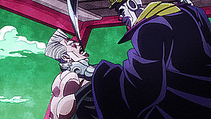
- On the assumption that Stands are images created out of energy, users possess the ability to slightly manipulate their form. This ability is mainly utilized within the first part featuring Stands, Stardust Crusaders. Jotaro uses this property to focus Star Platinum's energy into its fingertips to rapidly extend them for a piercing attack;[48] additionally, Stand users such as Kakyoin and Polnareff are able to freely shrink their Stands even to microscopic sizes.[49] However, Polnareff mentions that maintaining and manipulating a Stand's form at such a subtle level is taxing on the user's spiritual energy, making this property impractical in most cases.[49]
Power
Each Stand possesses an esoteric and unique power that defines it and sets it apart from other Stands.
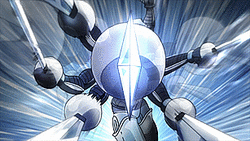
A Stand's power can wildly vary between Stands. The nature of the power can range from relatively mundane powers such as using a sword or controlling flames to extremely powerful ones such as the ability to manipulate the flow of time. These powers have many different subtleties, such as a limited range or a special way of manifesting themselves, that can be exploited during a fight. For instance, Sticky Fingers can create zippers on any surface, but it has to hit an object with its hand to be able to create them. It is up to the user to know how to protect themselves or use their enemy's weakness to their advantage.
The user is sometimes immune, or protected to a degree against the power of their Stand. For instance, Prosciutto can stay young despite his The Grateful Dead aging everyone around it. However, the reverse is just as widespread, as Stand users like Pannacotta Fugo with Purple Haze's virus, and Muhammad Avdol and Magician's Red's flames are stated to be just as vulnerable.
In rare cases, Stands can have the same abilities. Usually, siblings like the D'Arby Brothers or two rats can roughly have the same power.
Barring rare exceptions, if the Stand is destroyed or the user is knocked out, the Stand's power immediately disappears and any modification to the environment due to its power is reversed.
Each Stand is unique, but many share enough characteristics that they may be grouped under specific Stand Types. Uncommon special Stands may appear in the story from time to time due to exceptional circumstances.
Despite the variety of powers shown throughout the series, no Stand has the ability to truly bring back a person whose soul has departed.[50]
Range
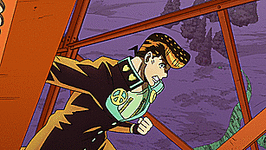
One of the most important features of a Stand is its range. Stands in principle can only be used within a predetermined range centering around the Stand's owner. As such, for the sake of convenience, the range that a Stand can perform abilities is referred to as "Firing Range" (射程距離). A Stand's range and accuracy are inversely proportional; the further the Stand moves away from its firing range, the weaker and less subtle it becomes. This principle is applied to almost all Stands. Furthermore, this can be construed more specifically as an "effective firing range", as a Stand will only gradually lose effectiveness the further it deviates from its firing range, rather than just relinquish immediately.[43] The Stand's range is effectively just the range where it can optimally perform, though this can notably fluctuate depending on the emotional state of the user.[51]
From a general point of view, all Stands can be roughly divided into two types: "short distance", and "long distance". As a trend, short-range types display great power, many of which excel at direct blows or destruction (Silver Chariot, Crazy Diamond, Sticky Fingers, etc.), and are often referred to as "Power Types". Long-range types typically have a special ability that lets them attack indirectly. (Hierophant Green, Echoes ACT1, Beach Boy, etc.)
Some long-distance types are referred to as "Automatic Pilot", in which the "power vs distance from user" principle does not apply, since autopilot types are typically an extension of an "effect" that results in a Stand triggering. As such, these Stands are independent of the Stand user's will and mental strength, and their power does not drop as a result. As a related note, certain Stand abilities do not have specified ranges (Earth Wind and Fire), an example being time-based powers, such as The World or King Crimson.[43]
Stand Parameters
- See also: Stand Stats
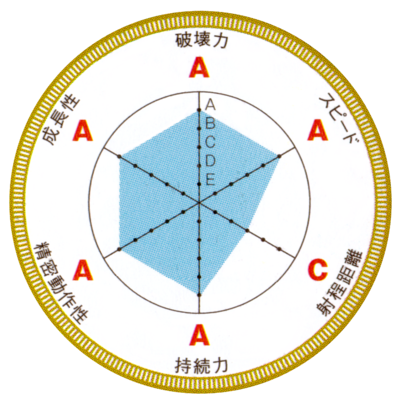
Stand Parameters (スタンドパラメータ, Sutando Paramēta), or Stand Statistics, are six statistics used outside of the story to gauge a Stand's capabilities. Some parameters refer to specific abilities of the Stand, such as in the case of Moody Blues and Whitesnake. They are, clockwise from top: Destructive Power, Speed, Range, Stamina, Precision, and Developmental Potential.
- Destructive Power (破壊力, Hakairyoku):
Measures the Stand's strength and ability to cause destruction (physical injury or collateral environmental damage) in a given period of time. Close-Range Stands such as Star Platinum, The World, Crazy Diamond, Killer Queen, Gold Experience and Stone Free will typically boast high destructive power (Rank C or higher). There are also cases like C-MOON, where destructive power is low or not applicable, despite having fairly destructive abilities.
- Speed (スピード, Supīdo):
Measures the Stand's agility and reflexes as well as performance speed. This is also typically evaluated fairly high for Close-range Stands. Sometimes it can be strengthened through training, such as with Stands like Silver Chariot.
- Range (射程距離, Shatei Kyori):
Measures a compromise of the Stand's range of manifestation, range of ability influence, and spatial mobility. In most cases, it is inversely proportional to destructive power. However, there are cases where both power and range are excellent, such as Red Hot Chili Pepper, Green Day, Weather Report, and Planet Waves although this is usually offset by having a low precision, or in the case of Red Hot Chili Pepper, requiring electricity to work. In addition, a Stand's range may decrease due to evolution, such as with Echoes and Made in Heaven.
- Stamina (持続力, Jizoku-ryoku):
Measures the duration of time that the Stand can actively maintain its ability. It can also be used in the sense of the time it takes before a special ability can be activated again, such as Star Platinum: The World's time stop.
- Precision (精密動作性, Seimitsu Dōsa-sei):
Measures the Stand's accuracy and range of influence/effect of their abilities to specified targets. Automatic-type Stands are generally evaluated with Rank D or under with a few exceptions.
- Development Potential (成長性, Seichō-sei):
Measures the Stand's possible functions, utilization of its abilities and powers, and capacity to improve its overall capabilities. It decreases in rank as the user masters their Stand. For example, Jotaro Kujo's Star Platinum is Rank A in Developmental Potential during Stardust Crusaders, but is given a Complete rank during Stone Ocean, as Jotaro has had many years to hone Star Platinum's power. For a Stand to gain an E-Ranking, it means that either their Stand user discovered all of their Stand's abilities or the Stand came with few abilities and thus cannot grow any more than it has. Stands such as Green Day and Notorious B.I.G, with infinitely increasing abilities, will be evaluated highly in this parameter.
Each statistic is ranked from A to E; though rankings of None and Infinite are also possible. If a rank is Unknown, it will show a question mark (?); this is usually because the Stand or its full capabilities have not yet been or will not be revealed in the storyline. Rankings are defined as follows:
- A: Very Good (超スゴイ, Chō Sugoi)
- B: Good (スゴイ, Sugoi)
- C: Average (人間と同じ, Ningen to Onaji, lit. "Comparable to a Human")
- D: Poor (ニガテ, Nigate)
- E: Very Poor (超ニガテ, Chō Nigate)
Stand Parameters were first introduced in Vento Aureo as part of a series of tailpieces inserted in specific chapters. Each page typically features information on a Stand relevant to the story arc, including their name, user, parameters, and description of their ability. Steel Ball Run and JoJolion do not display parameters, but Stands introduced during these arcs, as well as the arcs prior to Vento Aureo, are given them in artbooks.
Eyecatches
In the anime from Stardust Crusaders onward, Stand parameters appear as eyecatch illustrations displayed after commercials. In Diamond is Unbreakable, a silhouette of the Stand user is displayed as well. In Golden Wind, eyecatches are stylized by a spinning gold coin which transitions into the Stand and its information. In Stone Ocean, eyecatches are stylized by the text "Stone Ocean" written with Stone Free's string which transitions to the Stand and its information. Currently, Stands that don't have an anime version of their Stand parameters are Tenore Sax, Love Deluxe, Echoes ACT2, Achtung Baby, Ratt, Boy II Man, Burning Down the House, Marilyn Manson, and Bohemian Rhapsody. These eyecatches also feature the English language phrase "Stand Master" to refer to the user of the Stand, rather than "Stand User".
Stand Parameters are also used in weekly web radio programs like ORAORAdio and Morioh RADIO 4 GREAT to rate the hosts and guests.
Creation and Development
Araki had conceived his idea of Stand following a need to illustrate his character's abilities and drew inspiration from several sources. As the Vampires and therefore the Ripple, which was needed to fight them, became less relevant, there was a need to innovate the way characters in the series would fight each other. Araki mentions several trains of thought which would eventually lead into the creation of the Stands.
In several instances, Araki says that he was influenced by spiritualism, the ancestor cult of the Shinto religion giving him the idea of an otherworldly being protecting someone.[52][53] Moreover, Yokai legends and folklore would become one of the main inspirations for the Stands' appearances.[54] Araki also claimed that the concept of Stands were inspired by the 'guardian spirit' from Jiro Tsunoda's Ushiro no Hyakutarō manga.[55]
Alternatively, starting from the idea of psychic powers, Araki mentions that his natural skepticism about psychic powers inspired him to draw a psychic entity summoned by the characters. His interrogation about how psychic powers could affect the physical world without any medium led him into illustrating the psychic powers through Stands, which could make the reader visualize the way characters affected the world with their minds.[54] Araki mentions having in mind a punching fist coming out of the body to break an object, and thought that anything could be drawn, giving him a lot of artistic liberty.[56]
Araki explains that Stand abilities are often the first element he thinks of when he creates a character, and that he then develops the character's personality and appearance based on the harmony with said Stand power.[54][57]
A running theme in the Stand abilities of main antagonists is the power to manipulate time and/or space at some point. The World stops time, Killer Queen Bites the Dust loops time, King Crimson erases time, Made in Heaven accelerates the flow of time, Dirty Deeds Done Dirt Cheap travels through parallel dimensions, and Wonder of U manipulates calamity. This pattern stems from Araki's belief that the main antagonist should be overpowered and that if one were able to control space and time they would be unstoppable.[58]
Naming Convention
The Stands of the protagonists in Parts 3-6 follow a naming convention based on minerals: platinum, diamond, gold, and stone (Star Platinum, Crazy Diamond, Gold Experience, and Stone Free respectively).[59][60] The names of these Stands also refer to their own representative sub-titles of the parts that they appear in (e.g. Star Platinum, Stand of Jotaro Kujo from Stardust Crusaders).
In Stardust Crusaders, most of the first Stands introduced are named after the Major Arcana of the Tarot (early on, also modified by a color or metal name). Rider-Waite-Smith numbering is also used (the Justice card visual manifestation features the number eleven and Death Thirteen includes the tarot number in its name). Later on, the remaining Stands excluding The World, Cream, and Tenore Sax are named after Egyptian deities.
In JoJolion, the Stands in the Higashikata Family all have "King" in their names (Paper Moon King, Nut King Call, King Nothing, California King Bed, Speed King, Walking Heart, Awaking III Leaves, and Space Trucking). While Josuke Higashikata, adopted into the family, does not fall into this pattern, one of his components' Stands is named Killer Queen, whose name bearing Queen is a counterpart to the Higashikatas' Kings.
Like characters named after musical acts, the names of Stands named after musicians, albums or the such have historically been the subject of renaming in English localization of JoJo material, so as to avoid trademark infringement.
The running theme for Stand names in JORGE JOESTAR is movie titles. For example, Funny Valentine37's Stand is named after the film Singing in the Rain, Secco's Stand is named after the film The Evil Dead, and Jonathan Joestar's Stand is named after the film The Passion of the Christ (which is often shortened to "The Passion", thus the Stand's name).
In Purple Haze Feedback, every Stand introduced is named after a Jimi Hendrix song. The evolved form of Pannacotta Fugo's Stand is named after Purple Haze, Sheila E's Stand is named after Voodoo Child, Cannolo Murolo's Stand is named after Bob Dylan's All Along the Watchtower (covered by Hendrix), Massimo Volpe's Stand is named after Manic Depression, Vittorio Cataldi's Stand is named after Dolly Dagger, Vladimir Kocaqi's Stand is named after Rainy Day, Dream Away, and Angelica Attanasio's Stand is named after Night Bird Flying.
In El Aleph, the Stands introduced are named after novel titles. Fabio Ubuh's Stand is named after William Golding's Lord of the Flies, Izahela Mena-Mena's Stand is named after Julio Cortázar's Hopscotch, one Stand is named after Alejandro Carpentier's Écue-Yamba-O, Dos Santos's Stand is named after Mario Vargas Llosa's The Green House, Sasha Loggins's Stand is named after José Donoso's The Obscene Bird of Night, Octavio Luna Kan's Stand is named after Jorge Luis Borges's El Aleph, Pisco's Stand is named after José María Arguedas's Yawar Fiesta, Fernando Alhorn's Stand is named after Joseph Conrad's Heart of Darkness, and Lisa Lisa's Stand is named after Pearl S. Buck's The House of Earth trilogy.
References
- ↑ Chapter 116: Jotaro Kujo, Part 3
- ↑ Steel Ball Run Chapter 19: The Devil's Palm, Part 2
- ↑ Jump up to: 3.0 3.1 El Aleph Final Chapter: Epilogo
- ↑ JOJOVELLER: STANDS | Definition of a Stand, p.316
- ↑ Chapter 139: Yellow Temperance, Part 4
- ↑ Chapter 116: Jotaro Kujo, Part 3 p.7
- ↑ JOJOVELLER: Araki's Stand Commentaries - Chocolate Disco
- ↑ Steel Ball Run Extra Chapter 3: Untitled Stand Chapter, p.13-14
- ↑ Chapter 552: Pronto! On the Phone, Part 2
- ↑ Chapter 455: Joining the Gang, Part 6
- ↑ Chapter 114: Jotaro Kujo, Part 1
- ↑ Stone Ocean Chapter 129: Heavy Weather, Part 5
- ↑ Jump up to: 13.0 13.1 Chapter 121: The Power Called a "Stand"
- ↑ Chapter 538: Notorious B.I.G, Part 6
- ↑ Chapter 257: DIO's World, Part 11
- ↑ Chapter 445: Bucciarati is Coming, Part 3
- ↑ Chapter 504: Baby Face, Part 5
- ↑ Crazy Diamond's Demonic Heartbreak: Chapter 11
- ↑ Stone Ocean Chapter 12: The Visitor, Part 2
- ↑ JOJOVELLER: STANDS | Techniques to Stands, p.319
- ↑ Chapter 443: Bucciarati is Coming, Part 1
- ↑ Chapter 440: Gold Experience, Part 1
- ↑ Chapter 540: Spice Girl, Part 2
- ↑ Stone Ocean Chapter 20: Prisoner of Love
- ↑ Chapter 250: DIO's World, Part 4
- ↑ Chapter 520: The Mystery of King Crimson, Part 3
- ↑ Stone Ocean Chapter 103: Three Men Taken to the Hospital
- ↑ Chapter 147: Empress, Part 2
- ↑ Stone Ocean Chapter 75: Father: Jotaro Kujo, Daughter: Jolyne Cujoh
- ↑ JoJolion Chapter 51: Vitamin C and Killer Queen, Part 2
- ↑ xxxHolic Guidebook (November 2006)
- ↑ Chapter 552: Pronto! On the Phone, Part 2, p.13
- ↑ Chapter 569: A Little Story from the Past p.13
- ↑ El Aleph Chapter 3: III - Guatemala Arc
- ↑ El Aleph Chapter 1: I - Guatemala Arc
- ↑ El Aleph Chapter 13: XIII - Final Arc
- ↑ JoJolion Chapter 22: Morioh 1901
- ↑ JoJolion Chapter 6: Soft & Wet, Part 5
- ↑ JoJolion Chapter 8: California King Bed, Part 1
- ↑ Steel Ball Run Chapter 19: The Devil's Palm, Part 2
- ↑ Steel Ball Run Chapter 27: Tusk, Part 3
- ↑ JoJolion Chapter 99: The Wonder of You, Part 16
- ↑ Jump up to: 43.0 43.1 43.2 JOJO A-GO!GO!: STANDS - Standlogy, pp. 84, 103-105, 118-120
- ↑ Chapter 206: "Sethan" Alessi, Part 2
- ↑ JoJolion Chapter 64: Mother and Child
- ↑ Chapter 115: Jotaro Kujo, Part 2
- ↑ Chapter 152: Wheel of Fortune, Part 3, p.3
- ↑ Chapter 129: Dark Blue Moon, Part 3, p.19
- ↑ Jump up to: 49.0 49.1 Chapter 163: Lovers, Part 4
- ↑ Chapter 270: Josuke Higashikata! Meets Angelo, Part 2, p.17
- ↑ Crazy Diamond - Vol.12 "Shueisha Jump Remix Diamond is Unbreakable Edition" P94 What is the STAND?
- ↑ AnimeLand (June 2003)
- ↑ Les dossiers du Manga Vol. 7 (June 2003)
- ↑ Jump up to: 54.0 54.1 54.2 JoJo 6251 (December 1993)
- ↑ Weekly Shonen Brackets 100Q (April 2003)
- ↑ Phantom Blood PS2 (October 2006)
- ↑ Manga in Theory and Practice; Chapter 3: Designing Characters; Special Abilities and Finishing Moves, the origins of Stands.
- ↑ Tokai Lecture (June 2006)
- ↑ JOJO A-GO!GO!: Araki Hirohiko, p.61
- ↑ Billboard Japan (August 2021)
